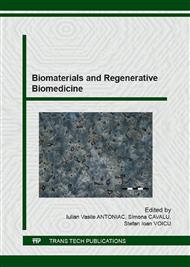[1]
Charnley J. Repair of bone in contact with acrylic cement. In: Acrylic cement in orthopaedic surgery. E & S Livingstone, Edinburgh (1970) pp.67-71.
Google Scholar
[2]
Lewis G, Bhattaram A. Influence of a pre-blended antibiotic (gentamicin sulfate powder) on various mechanical, thermal, and physical properties of three acrylic bone cements J Biomater Appl. 2006 Apr; 20(4): 377-408.
DOI: 10.1177/0885328206055124
Google Scholar
[3]
Huo MH, Waldman BJ. Cemented total hip replacement. In: Clinical orthopaedics. Craig EV (ed). Lippincott Williams & Williams, Baltimore (1999) pp.522-534.
Google Scholar
[4]
Park JB. Orthopaedic prosthesis fixation. In: The biomedical engineering handbook. Bronzino JD (ed). CRC Press Inc., Boca Raton (1995) pp.704-723.
Google Scholar
[5]
Jaeblon T (2010). Polymethylmethacrylate: properties and contemporary uses in orthopaedics. J Am Acad Orthop Surg 18: 297-305.
Google Scholar
[6]
Josefsson G, Kolmert L. Prophylaxis with systematic antibiotics versus gentamicin bone cement in total hip arthroplasty. A ten-year survey of 1, 688 hips. Clin Orthop. 1993; 292: 210-214.
DOI: 10.1097/00003086-199307000-00026
Google Scholar
[7]
Wentworth SJ, Masri BA, Duncan CP, Southworth CB. Hip prosthesis of antibiotic-loaded acrylic cement for the treatment of infections following total hip arthroplasty. J Bone Joint Surg Am. 2002; 84 (Suppl): 123-128.
DOI: 10.2106/00004623-200200002-00017
Google Scholar
[8]
Adams K, Couch l, Cierny G, Calhoun J, Mader JT (1992). In vitro and in vivo evaluation of antibiotic diffusion from antibiotic-impregnated polymethymethacrylate beads. Clin Orthop 278: 244–252.
DOI: 10.1097/00003086-199205000-00037
Google Scholar
[9]
Persson C, Baleani M, Guandalini L, Tigani D, Viceconti M. Mechanical effects of the use of vancomycin and meropenem in acrylic bone cement. Acta Orthop. 2006; 77(4): 617-21.
DOI: 10.1080/17453670610012692
Google Scholar
[10]
Nijhof MW, Stallmann HP, Vogely HC et al. Prevention of infection with tobramycin-containing bone cement or systemic cefazolin in an animal model. J Biomed Mater Res (2000) 52: 709-715.
DOI: 10.1002/1097-4636(20001215)52:4<709::aid-jbm16>3.0.co;2-w
Google Scholar
[11]
Schurman DJ, Trindade C, Hirshman HP, Moser K, Kajiyama G, Stevens P. Antibiotic-acrylic bone cement composites. Studies of gentamicin and Palacos. J Bone Joint Surg Am (1978) 60: 978-984.
DOI: 10.2106/00004623-197860070-00019
Google Scholar
[12]
Wahlig H, Dingeldein E, Buchholz HW, Buchholz M, Bachmann F. Pharmacokinetic study of gentamicin-loaded cement in total hip replacements. Comparative effects of varying dosage. J Bone Joint Surg Br (1984) 66: 175-179.
DOI: 10.1302/0301-620x.66b2.6707051
Google Scholar
[13]
Van de Belt H, Neut D, Schenk W, Van Horn JR, Van der Mei HC, Busscher HJ. Staphylococcus aureus biofilm formation on different gentamicin-loaded polymethylmethacrylate bone cements. Biomaterials (2001) 22: 1607-1611.
DOI: 10.1016/s0142-9612(00)00313-6
Google Scholar
[14]
Koo KH, Yang JW, Cho SH et al. Impregnation of vancomycin, gentamicin, and cefotaxime in a cement spacer for two-stage cementless reconstruction in infected total hip arthroplasty. J Arthroplasty (2001) 16: 882-892.
DOI: 10.1054/arth.2001.24444
Google Scholar
[15]
Kuehn KD, Ege W, Gopp U. Acrylic bone cements: composition and properties. Orthop Clin North Am. 2005 Jan; 36(1): 17-28.
DOI: 10.1016/j.ocl.2004.06.010
Google Scholar
[16]
Chiu FY, Chen CM, Lin CF, Lo WH (2002) Cefuroxime-impregnated cement in primary total knee arthroplasty: a prospective, randomized study of three hundred and forty knees. J Bone Joint Surg (Am) 84: 759-762.
DOI: 10.2106/00004623-200205000-00009
Google Scholar
[17]
Parvizi J, Saleh KJ, Ragland PS, Pour AE, Mont MA (2008) Efficacy of antibiotic-impregnated cement in total hip Replacement: A meta-analysis. Acta Orthop 79: 335-341.
DOI: 10.1080/17453670710015229
Google Scholar
[18]
Bourne RB (2004) Prophylactic use of antibiotic bone cement: an emerging standard in the affirmative. J Arthroplasty 19: 69–72.
DOI: 10.1016/j.arth.2004.03.005
Google Scholar
[19]
He Y, Trotignon JP, Loty B, Tcharkhtchi A, Verdu J. Effect of antibiotics on the properties of poly(-methylmethacrylate)-based bone cement. Biomed Mater Res. 2002; 63: 800-806.
DOI: 10.1002/jbm.10405
Google Scholar
[20]
Powles JW, Spencer RF, Lovering AM. Gentamicin release from old cement during revision hip arthroplasty. J Bone Joint Surg Br. 1998; 80: 607-610.
DOI: 10.1302/0301-620x.80b4.0800607
Google Scholar
[21]
Thomes B, Murray P, Bouchier-Hayes D. Development of resistant strains of Staphylococcus epidermidis on gentamicin-loaded bone cement in vivo. J Bone Joint Surg Br. 2002; 84: 758-760.
DOI: 10.1302/0301-620x.84b5.0840758
Google Scholar
[22]
Jiranek WA, Hanssen AD, Greenwald AS (2006) Antibiotic-loaded bone cement for infection prophylaxis in total joint replacement. J Bone Joint Surg (Am) 88: 2487-2500.
DOI: 10.2106/jbjs.e.01126
Google Scholar
[23]
Isefuku S, Joyner CJ, Simpson AH. Gentamicin may have an adverse effect on osteogenesis. J Orthop Trauma. 2003; 17: 212-216.
DOI: 10.1097/00005131-200303000-00010
Google Scholar
[24]
Virto MR, Frutos P, Torrado S, Frutos G. Gentamicin release from modified acrylic bone cements with lactose and hydroxypropylmethylcellulose. Biomaterials (2003) 24: 79-87.
DOI: 10.1016/s0142-9612(02)00254-5
Google Scholar
[25]
Haddad FS, Muirhead-Allwood SK, Manktelow AR, Bacarese-Hamilton I. Two-stage uncemented revision hip arthroplasty for infection. J Bone Joint Surg Br (2000) 82: 689-694.
DOI: 10.1302/0301-620x.82b5.0820689
Google Scholar


